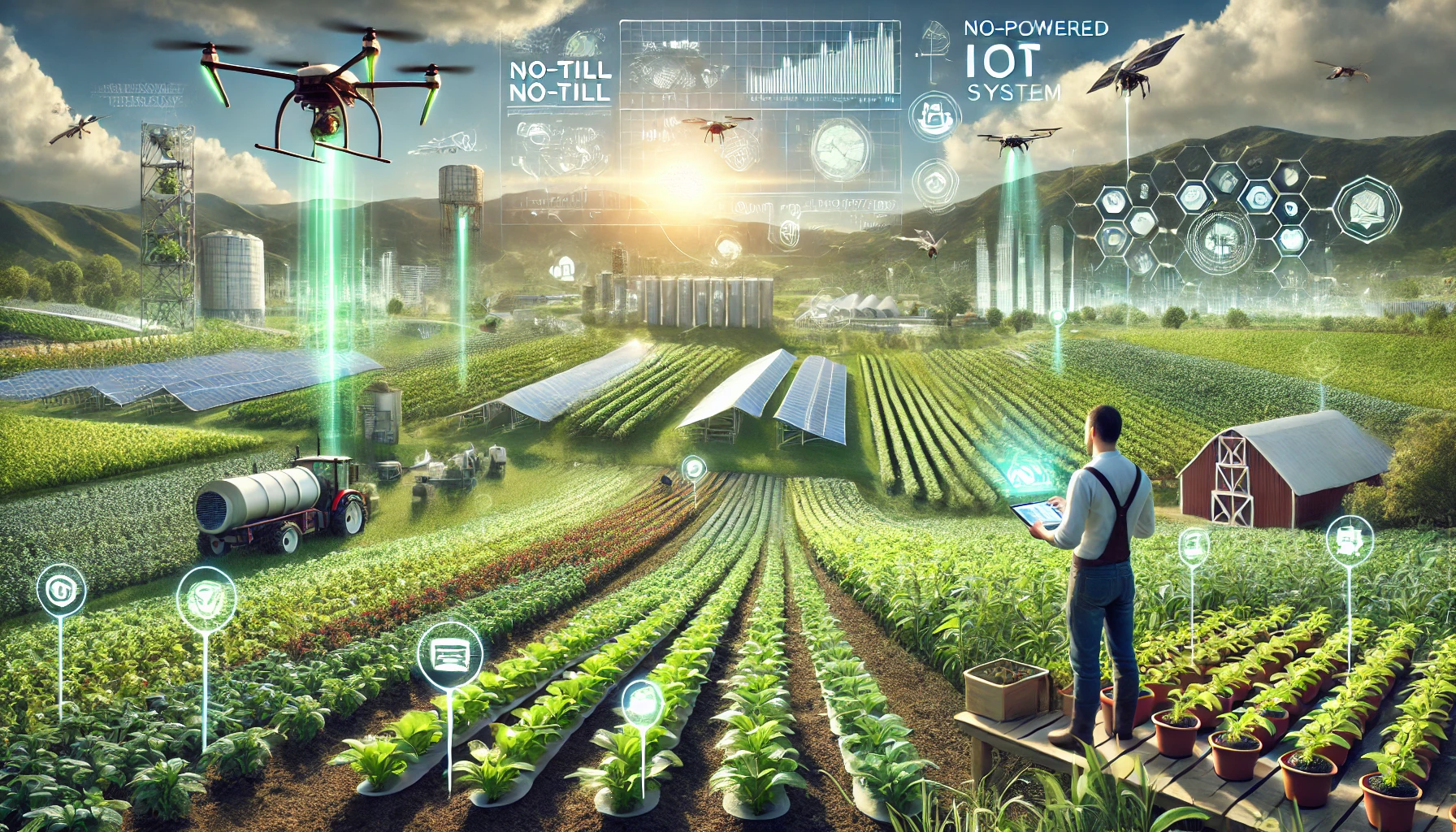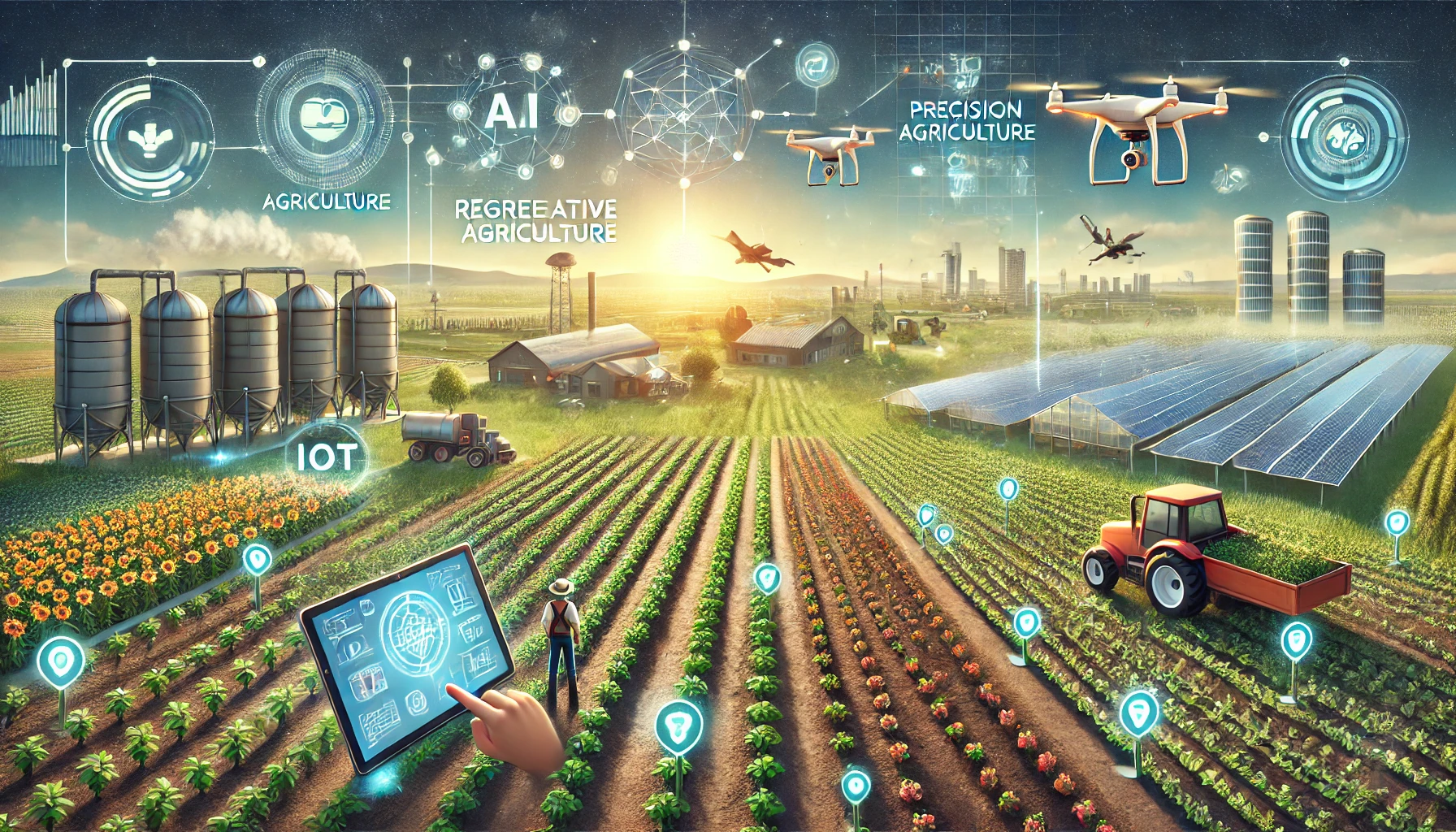
Introduction
Regenerative agriculture (RA) is transforming modern farming through agroecology by focusing on restoring soil health, enhancing biodiversity, and promoting sustainable farming practices. Unlike conventional agriculture, which often depletes natural resources, RA seeks to rebuild soil fertility, increase carbon sequestration, and reduce environmental impact. By integrating regenerative farming practices with cutting-edge technological innovations such as artificial intelligence (AI), precision agriculture, and digital agriculture, farmers can optimize their yields while supporting a sustainable food system.
In this in-depth guide, we will explore the core principles of regenerative agriculture, its significance in combating climate change, the role of technology in modern farming, and real-world examples of successful implementation. We will also discuss the challenges faced by farmers adopting regenerative practices and the policies, education, and funding initiatives necessary to support the global transition towards sustainable food systems.
What Is Regenerative Agriculture?
Regenerative agriculture (RA) is a holistic approach to farming that prioritizes soil health, biodiversity, and ecosystem services. The goal of RA is to enhance soil fertility, reduce dependence on synthetic fertilizers, and minimize soil disturbance, creating a self-sustaining agricultural system that benefits both the environment and farm incomes.
Definition and Concept of Regenerative Agriculture
There is no universal definition of regenerative agriculture, as different organizations and experts offer varying interpretations. However, RA is often regarded as a “beyond sustainability” approach that not only maintains natural resources but actively improves them.
Key principles of regenerative agricultural practices include:
-
Minimal soil disturbance (no-till or low-till farming)
-
Diversification of crops (polycultures, crop rotation, and agroforestry)
-
Use of cover crops to protect and nourish the soil
-
Integration of livestock to enhance nutrient cycling
-
Reduction of synthetic inputs (chemical fertilizers and pesticides)
-
Carbon sequestration through improved soil management
The Importance of Soil Health
Soil is the foundation of food production and plays a critical role in maintaining ecosystem services, including water filtration, carbon sequestration, and biodiversity. However, soil degradation, caused by intensive farming practices, erosion, and excessive use of synthetic fertilizers, threatens agricultural sustainability by depleting soil organic matter.
Soil Health and Its Impact on the Environment
Healthy soils store carbon, improve water retention, filter water, and support microbial biodiversity, making them essential for a resilient global food system. Unfortunately, over 33% of the world’s soils are degraded, and industrial agriculture is a significant contributor to this issue.
How Regenerative Practices Improve Soil Health
-
Cover crops prevent erosion and improve soil organic matter
-
Composting and organic fertilizers restore soil nutrients naturally
-
Crop rotation and polyculture farming reduce pest and disease outbreaks
-
Reducing chemical inputs helps maintain microbial biodiversity
-
Nutrient cycling enhances soil fertility and structure
The Agricultural Sector and Sustainability
Agriculture is a major contributor to greenhouse gas emissions (GHGs), accounting for nearly 24% of global emissions. Industrial farming relies on synthetic fertilizers, monocultures, and chemical pesticides, leading to soil depletion, water pollution, and biodiversity loss.
Regenerative agriculture presents an opportunity to promote sustainable farming practices by:
-
Reducing reliance on chemical inputs
-
Enhancing carbon sequestration in soil
-
Promoting crop diversification for resilient farming systems
Indigenous Roots and Cultural Aspects
Regenerative agriculture is deeply rooted in the traditional farming practices of indigenous communities, who have long understood the importance of maintaining soil health, biodiversity, and ecosystem services. For centuries, these communities have employed techniques such as crop rotation, cover cropping, and conservation tillage to sustain soil fertility and promote ecosystem health. These practices are not merely agricultural methods but are integral to the cultural heritage and way of life of indigenous peoples.
Indigenous farming practices reflect a profound understanding of the interconnectedness of all living things. This holistic approach to farming ensures that the land remains productive and healthy for future generations. By adopting regenerative practices, modern farmers can honor and respect this traditional knowledge, promoting sustainable agriculture and contributing to a more sustainable future.
Regenerative agriculture is more than just a set of farming techniques; it is a way of life that emphasizes the relationship between the land and the community. By preserving and promoting these traditional practices, we can enhance cultural diversity and ensure that valuable knowledge is passed down through generations. Indigenous communities play a critical role in promoting regenerative agriculture and sustainable farming practices, and their involvement is essential for creating a more equitable and sustainable food system.
By working together, we can leverage the wisdom of indigenous communities to promote a more sustainable and resilient agricultural sector. This collaboration can help us build a food system that benefits all communities, ensuring a healthier planet for future generations.
The Role of Technology in Regenerative Agriculture
Driving Innovation in Regenerative Agriculture

Advancements in technology and artificial intelligence (AI) are accelerating the adoption of regenerative agriculture practices by providing farmers with data-driven insights to improve decision-making. Some key innovations include:
-
Precision agriculture tools that optimize input use (fertilizers, water, pesticides)
-
Vertical farming to enhance urban food production
-
Blockchain technology to improve transparency in food supply chains
-
AI-driven crop monitoring to detect diseases early and enhance productivity
-
Remote sensing to gather real-time data on soil health and crop conditions
Precision Farming and AI in Regenerative Agriculture
AI-powered data analytics and machine learning help farmers predict weather patterns, optimize irrigation, and monitor crop health using IoT sensors and satellite imagery. This not only increases efficiency but also reduces environmental impact.
Blockchain for Supply Chain Transparency
Blockchain technology is being used to track, verify the authenticity, and ensure traceability of regeneratively produced food, ensuring consumers have access to transparent information about sourcing and sustainability.
Empowering Farmers Through Technology
Technology has the potential to revolutionize regenerative agriculture by empowering farmers with the tools and insights they need to optimize their practices. Precision agriculture and precision irrigation, for example, enable farmers to maximize crop yields while minimizing waste, ensuring that resources are used efficiently and sustainably.
Advanced crop monitoring and management systems provide farmers with valuable data on soil health and crop health, allowing them to identify areas where regenerative practices can be improved. Drones and satellite imaging offer real-time insights into field conditions, helping farmers make informed decisions about soil management and crop care.
Artificial intelligence and machine learning are also playing a significant role in regenerative agriculture. These technologies can analyze vast amounts of data to help farmers predict weather patterns, optimize irrigation schedules, and monitor crop health. By leveraging AI-driven tools, farmers can enhance their decision-making processes and implement more effective regenerative practices.
Blockchain technology is another powerful tool for promoting transparency and trust in the food supply chain. By tracking and verifying regenerative practices, blockchain can ensure that consumers have access to accurate information about the sustainability of their food. This transparency can help build consumer trust and support for sustainable agriculture.
Regenerative agriculture apps are making it easier for farmers to access information and resources related to sustainable practices. These apps provide guidance on implementing regenerative techniques, connecting farmers with experts and peers who can offer support and advice.
By embracing technology, farmers can reduce greenhouse gas emissions, promote carbon sequestration, and contribute to a more sustainable future. Technology not only enhances the efficiency and effectiveness of regenerative practices but also helps farmers connect with consumers and promote sustainable agriculture. Through the integration of technology and traditional knowledge, we can create a resilient and sustainable agricultural sector that benefits both people and the planet.
Challenges and Opportunities in Regenerative Agriculture
While regenerative agriculture offers numerous benefits, there are challenges to its widespread adoption, including:
-
Limited awareness and understanding of regenerative practices
-
Initial costs and investment required for transition
-
Economic incentives that favor conventional farming methods
Key Challenges:
-
Scalability issues in large-scale commercial farming
-
High initial investment costs for transitioning to regenerative systems
-
Lack of awareness and education among farming communities
-
Market barriers and lack of economic incentives
Opportunities:
-
Government incentives and subsidies for sustainable farming
-
Private-sector investments in regenerative agriculture projects
-
Consumer demand for sustainable food products
Case Studies: Successful Regenerative Agriculture Projects
1. Singing Frogs Farm, USA
-
Uses IoT sensors for precision irrigation
-
Maintains a no-till farming system
2. Bowles Farming Company, USA
-
Utilizes AI-driven platforms to analyze satellite imagery
-
Drones monitor crop health and soil moisture
3. The Agrarian Freedom Project, Zimbabwe
-
Employs solar-powered IoT sensors to optimize irrigation
-
Regenerative techniques restore degraded land
Funding, Policy, and Education for Regenerative Agriculture
Securing Funding for Regenerative Agriculture Initiatives
Governments, NGOs, and private investors are providing funding for sustainable agriculture initiatives. Impact investors are increasingly focusing on regenerative agriculture as a means to combat climate change and improve food security.
Policy and Regulation: Creating a Supportive Environment
Policymakers can promote regenerative agriculture by:
-
Providing subsidies for sustainable farming practices
-
Encouraging data transparency through blockchain technology
-
Supporting education and training programs
Education and Training: Building Capacity for Regenerative Agriculture
Farmers require education and hands-on training to successfully transition to regenerative agriculture. Online courses, workshops, and government programs can bridge the knowledge gap.
Conclusion: The Future of Regenerative Agriculture

Regenerative agriculture has the potential to transform modern farming, enhance soil fertility, and combat climate change. However, its widespread adoption depends on continued technological innovation, supportive policies, financial incentives, and education initiatives.
By integrating precision agriculture, AI-driven tools, and blockchain technology, farmers can improve crop health while ensuring sustainable food production. The future of regenerative agriculture lies in collaborative efforts between policymakers, farmers, researchers, and technology developers to create a resilient and sustainable global food system.
For more insights, visit Rodale Institute and Regenerative Agriculture Foundation.

ySdgMuQ ZCbODnhG AOlSbQOq YpNIu yTU lkxrKXR